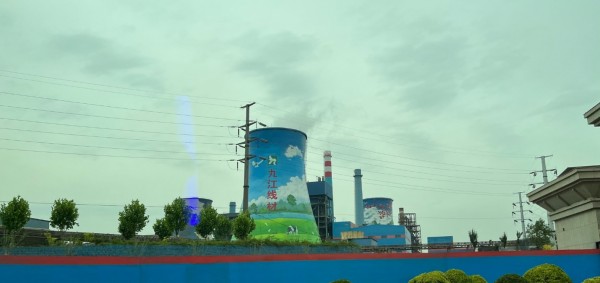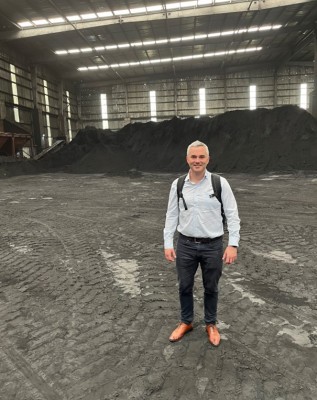Senior Research Analyst Øyvinn Rimer presents his noteworthy insights and discoveries from a recent visit to China, where he visited more than 30 companies spanning diverse industries. Despite prevailing pessimism, certain winners emerged, and indications suggest an imminent shift towards a favourable upturn.
China property, prospective policy and iron ore – how low can it go?
After a long four years, we were finally back on the ground in China in May and June, taking the temperature of the broader economy, the resources sector and the consumer. It didn’t take much to notice that China is still far from where it was pre-COVID in terms of sentiment, consumer activity and general business. The streets were emptier, the tourists missing, the malls now more of a thoroughfare and place to eat than to part with precious cash in stores; and the air cleaner than what you could expect when steel production is still holding at record levels.

Tangshan Steel Mill – Photo Harbour
In all our meetings, we asked our counterparts about their personal views of property, child rearing and general willingness to spend. The feedback was overwhelmingly bearish, with not a single individual thinking now is a good time to buy property, and those who owned multiple properties had either recently sold or are looking to get out. Property – the multi-decade long engine for growth and confidence in the Chinese economy – has never in my memory experienced such a negative sentiment – maybe so bearish that the downside from here may be limited!
Property, which has been in decline for a couple of years now, holds significance for steel demand and Australian iron ore. We hold the view that raw materials like iron ore may be highly responsive to targeted stimulus for the property sector due to exceedingly low confidence levels and depleted iron ore inventories at steel mills and traders.
Despite the weakness in property construction, steel demand has held up on the back of strong infrastructure investments (government led) and robust steel exports. Neither of these are perceived as particularly sustainable, with only a property recovery likely to drive growth in steel production from here. That hinges on targeted stimulus to drive consumer confidence in the sector again, having previously installed relatively draconian policies to restrict property investments.
Although rumours of pending stimulus are rife, most industry contacts don’t believe there will be grand stimulus packages for the sector, and even if there are, they are likely to be ineffective until the consumer regains confidence in developers and property as a sensible asset class – this will take time.
Longer term, property is significantly challenged by the demographics of China where the population is forecast to drop by 100mn people by 2050 and by over 600mn people by 2100 – the need for investment to grow the housing stock is therefore limited.

Hebei Steel Mill – Photo Harbour
Offsetting the natural demographic drag on long-term steel demand is the Government’s plan to improve the housing stock to accommodate the growing middle class and its aspiration of improved living conditions. This type of development has not historically been supported by the private developers (who have prioritised the higher-end segment) but, following the Evergrande ripples a couple of years back, the state-owned enterprise (SOE) developers have taken significant market share and will be the driver of social housing developments in line with government policy. We are yet to be convinced that the demand for improved or upgraded dwellings will be enough to offset the sharply declining population.
Despite the challenging structural outlook, the fact that sentiment is generally extremely negative and iron ore inventory levels also very low, our view is that the downside is relatively protected from here. Should a stimulus package be announced, we are likely to see traders rush to restock and take the iron ore price higher in what could be a significant reaction. During our visit, we noticed strong performance in the share prices of China-facing property developers on relatively benign policy rumours, suggesting the market is hungry for Chinese stimulus and a little may go a long way.

Iron ore stockpiles at trader – Photo Harbour
The positives – green energy, electric vehicles and battery materials
The clear winners among the industries we visited are the new energy vehicles and green energy sectors. Electric vehicles, wind and solar power generation are in vogue and have strong organic growth momentum. Despite incentives having rolled off in 2022, electric vehicle sales are still robust. China is a clear leader in battery manufacturing and the respective raw material processing required to enable further growth. We met with several lithium companies, battery materials consultants and electric vehicle manufacturers to gauge the outlook and, whilst the sector has seen some recent hiccups from inventory overhang and subsequent destocking, the medium- to long-term outlook is strong. Interestingly, China now has price parity between battery electric and internal combustion engines, with range and charging infrastructure being the two remaining hurdles consumers cite when opting for an ICE (internal combustion engine) today.
For us, the best exposures to batteries or electric motors are lithium and copper. Having been very positive on rare earths prior to this trip, the consistent message from industry contacts was that the rare earth’s intensity is going down, and the biggest growth sector (wind turbines) is switching away from rare earths with a new generation of turbines not using any rare earths. Electric cars, air-conditioning, and industrial robots are still driving demand growth for rare earths today and we will be closely monitoring the technological developments that might reduce the need for rare earths going forward. In the anode space, the sentiment was very negative on graphite on the back of significant new processing capacity of synthetic graphite. It should be noted, however, that non-Chinese battery and electric car manufacturers are sensitive to the emissions profile of synthetic graphite and might still opt for natural graphite to be the primary anode material going forward.


Checking out the latest models from leading large NEV SUV manufacturer Li Auto. Photos by Harbour
Following our recent trip, we anticipate a probable continuation of policy support for NEVs (New Energy Vehicles) in China, which would serve as a favourable boost to demand. We also believe the short-term cost curve for lithium is steeper than first thought. The break-even costs for marginal production (Chinese Lepidolites mining) is significantly above market estimates and large ex-China mines take longer and cost more to develop. Hence, the medium-term outlook is strong, albeit subject to opaque channel inventory positioning and policy sensitivity. Overall, our view is that the inventory position of mined lithium, cathode precursor, finished cathodes, and batteries is relatively balanced. Some pockets of inventory remain, and several market participants say they are holding inventory strategically as they believe the market is going up.
As investors, we like it when consensus is made up of a big difference in views, and electric vehicle penetration by 2030 is one of these data points where the market is widely spread. We heard convincing arguments as to why it will be 50% and why it will be >80% in China by 2030. We are firmly in the higher group, given cost parity already achieved and significant charging infrastructure roll-out in the next 2-3 years. Not only do we believe penetration may be higher than expected, but the battery packs will likely be larger as well with consumers wanting more range. This is partially offset by strong growth in very small electric vehicles as well, which consumers principally use for inner-city driving and that use small battery packs with LFP cathodes. However, on average, the packs get bigger and require more lithium metal per unit.
The key economic agent to drive a sustained recovery – the consumer
Finally, the very cautious Chinese consumer is a part of the economy that is harder to reactivate than typical policy sectors like infrastructure. The consumer is still bruised after COVID, and whilst their savings are astronomical relative to any other economy, they are unwilling to part with the cash. This is due to uncertainties around salary growth, employment, the cost of education and healthcare, and the negative returns in the property sector – something not experienced for a generation. The reactivation of the Chinese consumer is, in our view, the biggest policy challenge facing Beijing, and also the most important one for sustained economic recovery.
Pleasingly, the feedback on Chinese/Australian relations was one of significant improvement, which bodes well for regional economic cooperation. Whilst the visa and customs experience has reached new levels of bureaucracy and friction, Australian corporates and investors have been busy travelling to China recently to work on bilateral relations and trade. The new Australian Government is also far less confrontational than its predecessor and there was a sense of strong momentum on the economic relationship. This could perhaps see certain trade restrictions being lifted ahead of expectations and we look specifically to wine tariffs, although we didn’t gain any views that this process is running ahead of expectations.
With respect to New Zealand’s a2 Milk, we observed a2’s positioning within the all-important mother and baby store channel, where its presence was fairly unchanged relative to previous visits. What was noticeable, was that competing brands already had the latest version of product on shelf after the new licence scheme started on 21 May 2023. a2 and Synlait only received the formal licence in early June and will take a number of months to manufacture and ship to China before being available on shelves. This poses a risk in the short-term that new parents opt for competing brands if they think availability might become an issue as a2 transitions to newly licenced formulas.
Beyond the implementation risks of the new products, a2 seems to be executing well in the Chinese market and has seen strong market share gains of late. We cannot tell for sure whether this is them taking share from the leading domestic brands and multi-national competitors or whether it is largely driven by a large number of smaller brands exiting the market due to the new licencing regime (estimated to be 20-25% of the market in the process of exiting). No doubt it is good to see a2 as a key beneficiary of the consolidation, but we reserve judgement of whether this is due to strong execution, or from picking up sales from brands exiting the market, or a combination of both.
In summary, we have never experienced sentiment as weak as on this trip, which is both frightening and encouraging at the same time, given that a lot of bad news is already expected. This sets a low bar for policy to have a positive effect and, whilst we don’t expect major policy akin to that of 2015 or 2009, a little may go a long way. Inventories at steel mills and iron ore traders are extremely low, so even the smallest policy initiative will likely drive a restocking cycle that can push prices significantly higher. Medium- to long-term winners may be the green energy and new energy vehicles sectors, with lithium and copper standing out to us as likely beneficiaries. Finally, the consumer is very pessimistic with no willingness to spend on goods nor invest in property at present. Policies to start the reignition of consumer confidence will not be easy to implement but are critical to get this important part of the economy back on its feet.
IMPORTANT NOTICE AND DISCLAIMER
This publication is provided for general information purposes only. The information provided is not intended to be financial advice. The information provided is given in good faith and has been prepared from sources believed to be accurate and complete as at the date of issue, but such information may be subject to change. Past performance is not indicative of future results and no representation is made regarding future performance of the Funds. No person guarantees the performance of any funds managed by Harbour Asset Management Limited.
Harbour Asset Management Limited (Harbour) is the issuer of the Harbour Investment Funds. A copy of the Product Disclosure Statement is available at https://www.harbourasset.co.nz/our-funds/investor-documents/. Harbour is also the issuer of Hunter Investment Funds (Hunter). A copy of the relevant Product Disclosure Statement is available at https://hunterinvestments.co.nz/resources/. Please find our quarterly Fund updates, which contain returns and total fees during the previous year on those Harbour and Hunter websites. Harbour also manages wholesale unit trusts. To invest as a wholesale investor, investors must fit the criteria as set out in the Financial Markets Conduct Act 2013.
